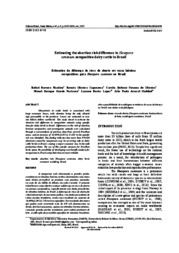Estimating the abortion risk difference in Neospora caninum seropositive dairy cattle in Brazil.
Estimating the abortion risk difference in Neospora caninum seropositive dairy cattle in Brazil.
Author(s): NICOLINO, R. R.; CAPANEMA, R. O.; OLIVEIRA, C. S. F. de; PASTRANA, M. E. O.; LOPES, L. B.; HADDAD, J. P. A.
Summary: Neosporosis in cattle herds is associated with large economic losses, with abortion being the only clinical sign perceptible to the producer. Losses are estimated at over one billion dollars worldwide. This study aimed to estimate the abortion risk difference in seropositive animals using specific data for dairy herds in Brazil. Differences in the risk of abortion between seropositive and seronegative animals were calculated through a meta-analysis of previous data from several Brazilian states, and an increase of 10.04% (0.091 to 0.118) in the specific risk was identified. This finding indicates that more than 474,000 abortions caused by neosporosis may be occurring only in dairy cattle herds in Brazil, causing a major economic loss in the milk production chain. The use of this specific measure for Brazilian herds opens the possibility of developing cost?benefit analysis for neosporosis in Brazil using data that are more reliable.
Publication year: 2015
Types of publication: Journal article
Observation
Some of Embrapa's publications are published as ePub files. To read them, use or download one of the following free software options to your computer or mobile device. Android: Google Play Books; IOS: iBooks; Windows and Linux: Calibre.
Access other publications
Access the Agricultural Research Database (BDPA) to consult Embrapa's full library collection and records.
Visit Embrapa Bookstore to purchase books and other publications sold by Embrapa.

